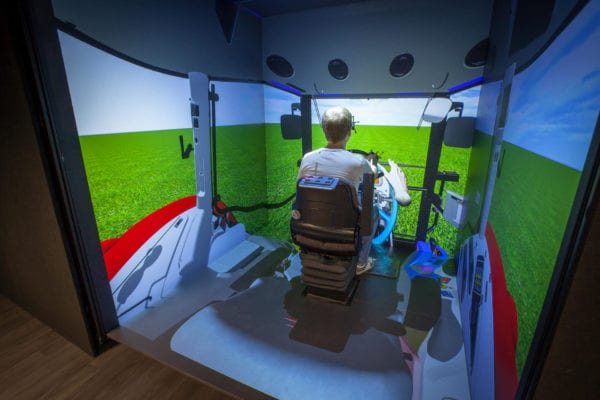

The CAVE(Cave AutomaticVirtual Environment) was developed at the University of Illinois at Chicagoand provides the illusion of immersion by projecting stereo images on thewalls and floor of a room-sized cube. Better, significantly improved HMD devices and projection-based systems like the CAVE have taken over. Update Note: The BOOM device has mostly disappeared from the market. Head tracking isaccomplished via sensors in the links of the arm that holds the box. The user looks intothe box through two holes, sees the virtual world, and can guide the box toany position within the operational volume of the device. Screens and optical system arehoused in a box that is attached to a multi-link arm. The BOOM (Binocular Omni-Orientation Monitor) from Fakespace is ahead-coupled stereoscopic display device. To overcome the often uncomfortable intrusiveness of a head-mounteddisplay, alternative concepts (e.g., BOOM and CAVE) for immersive viewingof virtual environments were developed. A motion tracker continuously measuresthe position and orientation of the user's head and allows the imagegenerating computer to adjust the scene representation to the current view.As a result, the viewer can look around and walk through the surroundingvirtual environment. It took more then 20 years before VPL Research introduced a commercially available HMD, the famous "EyePhone" system (1989).Ī typical HMD houses two miniature display screens and an optical systemthat channels the images from the screens to the eyes, thereby, presentinga stereo view of a virtual world. Evans and Sutherland demonstrated ahead-mounted stereo display already in 1965. The head-mounted display (HMD) was the first device providing its wearerwith an immersive experience.

Originally, the term referred to'Immersive Virtual Reality.' In immersive VR, the user becomes fullyimmersed in an artificial, three-dimensional world that is completelygenerated by a computer. Today, 'Virtual Reality' is used in a variety of ways and often in aconfusing and misleading manner. Other related terms include 'ArtificialReality' (Myron Krueger, 1970s), 'Cyberspace' (William Gibson, 1984), and,more recently, 'Virtual Worlds' and 'Virtual Environments' (1990s). The term 'Virtual Reality' (VR) was initially coined by Jaron Lanier,founder of VPL Research (1989). Some important 'Update Notes' have been added (in cursive). Things have changed by now, but the principles still hold. Note: This article was first written around 1999-2000. Terminology Head-Mounted Display (HMD) BOOM CAVE Input Devices and other Sensual Technologies Characteristics of Immersive VR Shared Virtual Environments Non-immersive VR VRML VR-related Technologies Applications Virtual Reality: A Short Introduction by K.-P. UM-VRL: Virtual Reality: A Short Introduction


 0 kommentar(er)
0 kommentar(er)
